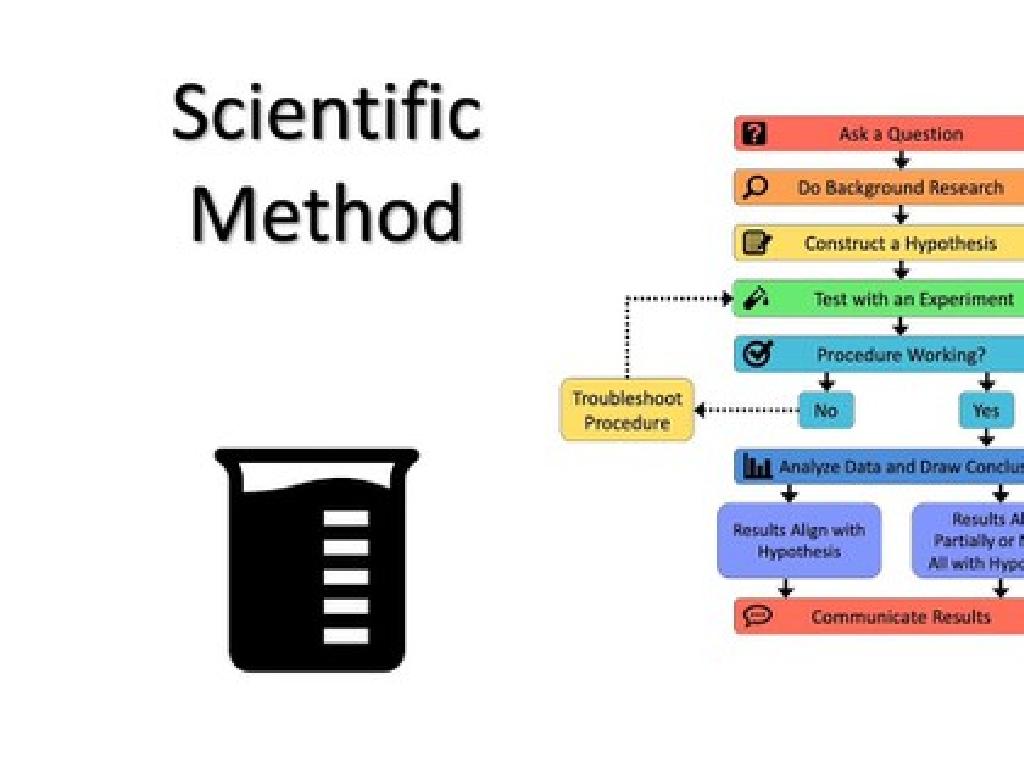Choose Between Personal And Reflexive Pronouns
Subject: Language arts
Grade: Sixth grade
Topic: Pronoun Types
Please LOG IN to download the presentation. Access is available to registered users only.
View More Content
Pronoun Types: Personal & Reflexive
– Define personal pronouns
– Words like ‘I’, ‘you’, ‘he’, ‘she’, ‘it’, ‘we’, ‘they’
– Define reflexive pronouns
– Words that end in ‘-self’ or ‘-selves’, e.g., ‘myself’, ‘themselves’
– Role of pronouns in sentences
– They take the place of nouns to avoid repetition
– Choosing the correct pronoun
– Correct pronouns clarify who or what we’re talking about
|
This slide introduces students to the concept of personal and reflexive pronouns, which are essential components of English grammar. Personal pronouns replace specific names of people, places, and things, while reflexive pronouns are used when the subject and the object of the sentence are the same. Understanding the role of pronouns helps students create clear and concise sentences. Emphasize the importance of choosing the correct pronoun to maintain clarity in communication. Provide examples and encourage students to practice by identifying and using both types of pronouns in sentences.
Pronouns: Personal and Reflexive
– Pronouns take place of nouns
– Common pronouns: he, she, it, they
– Examples: He likes pizza. She runs fast.
– Pronouns prevent repetition
– Personal vs. Reflexive pronouns
– Personal: I, you, he, she, it, we, they. Reflexive: myself, yourself, himself, herself, itself, ourselves, yourselves, themselves.
|
Begin with a quick review of what pronouns are and their function in replacing nouns to avoid redundancy in speech and writing. Provide examples of common pronouns and use them in simple sentences. Highlight how pronouns enhance sentence variety and readability. Then, introduce the distinction between personal pronouns, which refer to a specific person or thing, and reflexive pronouns, which are used when the subject and the object of the sentence are the same. Provide examples for each and explain their proper use. Encourage students to identify and use both types of pronouns in their daily writing.
Personal Pronouns in Sentences
– Personal pronouns represent people or things
– Subjective pronouns: I, you, he, she, it, we, they
– Used as the subject of a sentence or clause
– Objective pronouns: me, you, him, her, it, us, them
– Used as the object of a verb or preposition
– Usage depends on the pronoun’s role in a sentence
– Choose subjective or objective based on sentence structure
|
This slide introduces personal pronouns and their roles in sentences. Personal pronouns can take the place of specific nouns and are categorized as subjective or objective based on their function. Subjective pronouns are used when the pronoun is the subject of the sentence, while objective pronouns are used when the pronoun is the object of a verb or preposition. It’s crucial for students to understand the difference to use pronouns correctly. Provide examples for each case and encourage students to create sentences using both subjective and objective personal pronouns to reinforce the concept.
Understanding Reflexive Pronouns
– Reflexive pronouns link back to the subject
– If ‘I’ do something to ‘me’, I use ‘myself’
– Singular and plural forms end in ‘-self’ or ‘-selves’
– ‘He’ talks to ‘himself’ shows ‘himself’ is reflexive
– Examples include ‘myself’, ‘ourselves’
– ‘I did the homework myself’ or ‘We did it ourselves’
– Used when the subject and object are the same
– ‘She prepared herself for the exam’ shows same subject and object
|
This slide introduces reflexive pronouns, which are used when the subject of a sentence is also the object. Explain that these pronouns always end in ‘-self’ for singular and ‘-selves’ for plural. Provide clear examples like ‘myself’, ‘yourself’, ‘himself’, ‘herself’, ‘itself’, ‘ourselves’, ‘yourselves’, and ‘themselves’. Emphasize that reflexive pronouns are necessary when the action of the verb refers back to the doer. Encourage students to create sentences using reflexive pronouns to ensure they grasp the concept. Discuss situations where reflexive pronouns are often used, such as emphasizing the subject’s role in the action or when the subject is both doing and receiving the action.
Choosing the Right Pronoun: Personal vs. Reflexive
– Personal vs. reflexive pronoun use
– Use personal pronouns like ‘he’ or ‘they’ to refer to people. Use reflexive pronouns like ‘himself’ when the person doing the action is also receiving the action.
– Personal pronouns as subjects or objects
– ‘I’ is a subject pronoun in ‘I run’, while ‘me’ is an object pronoun in ‘She called me.’
– Reflexive pronouns: subject = object
– Use ‘myself’ when the action reflects back on the subject, as in ‘I taught myself.’
– Practice with examples
|
This slide introduces the concept of choosing the appropriate pronoun type in a sentence. Personal pronouns are used to represent specific people or things and can act as either the subject or the object in a sentence. Reflexive pronouns are used when the subject and the object of the sentence are the same entity, and they end in ‘-self’ or ‘-selves.’ It’s crucial to give students clear examples to illustrate the difference. For instance, ‘She (subject) saw herself (reflexive object) in the mirror.’ Encourage students to create sentences using both types of pronouns to reinforce their understanding. Provide additional examples and exercises for practice.
Pronouns in Action: Personal vs. Reflexive
– Identify pronouns in sentences
– Determine pronoun type
– Is it personal (I, you, he, she) or reflexive (myself, yourself)?
– Correct pronoun usage
– Ensure pronouns match the subject and object in the sentence
– Practice with examples
– ‘I did the homework myself.’ vs. ‘She helped me with the homework.’
|
This slide is aimed at helping students distinguish between personal and reflexive pronouns through practice and correction. Start by explaining the difference between the two types: personal pronouns refer to a specific person or thing, while reflexive pronouns are used when the subject and the object of the sentence are the same. Encourage students to identify pronouns in given sentences and decide their type. If a pronoun is used incorrectly, students should correct it. Provide examples and guide them through the process of identifying and correcting pronouns. For instance, ‘I did the homework myself.’ uses a reflexive pronoun correctly, whereas ‘Me went to the store.’ should be corrected to ‘I went to the store.’ using a personal pronoun.
Practice Time: Personal vs. Reflexive Pronouns
– Practice choosing the correct pronoun
– Work through examples as a class
– We’ll look at sentences and decide which pronoun fits best
– Explain why you chose a pronoun
– Share your reasoning with the class for your choices
– Gain confidence in pronoun usage
|
This slide is designed for an interactive class activity focused on distinguishing between personal and reflexive pronouns. Start by reviewing the definitions and examples of each type of pronoun. Then, present sentences that are missing pronouns and ask students to fill in the blanks with the appropriate personal or reflexive pronouns. Encourage students to explain their choices to foster a deeper understanding and to correct any misconceptions. This activity will help students become more confident in their ability to choose the correct pronoun in various contexts. Prepare a list of sentences in advance for this activity, ensuring a mix of cases where personal and reflexive pronouns would be appropriate.
Class Activity: Pronoun Hunt
– Find personal & reflexive pronouns in a book
– Write the sentence with the pronoun
– Identify the type of each pronoun
– Personal: ‘I, you, he, she, it, we, they’, Reflexive: ‘myself, yourself, himself, herself, itself, ourselves, yourselves, themselves’
– Explain why the pronoun fits the sentence
– Think about the role of the pronoun in the sentence
|
This activity is designed to help students recognize and differentiate between personal and reflexive pronouns in the context of literature they are familiar with. Encourage students to choose their favorite book to make the activity engaging. They should look for sentences that contain personal pronouns (I, you, he, she, it, we, they) and reflexive pronouns (myself, yourself, himself, herself, itself, ourselves, yourselves, themselves) and write them down. Then, they should identify which pronouns are used and explain their choice, focusing on the function of the pronoun in the sentence. For example, a reflexive pronoun is used when the subject and the object of the sentence are the same. During the next class, students will share their sentences and explanations, fostering a deeper understanding of pronoun usage and enhancing peer learning.
Conclusion & Homework: Pronouns Mastery
– Recap: Pronoun importance
– Homework: Craft 10 sentences
– Include 5 sentences with personal pronouns and 5 with reflexive pronouns.
– Use personal & reflexive pronouns
– Examples: ‘I did this myself.’ (reflexive), ‘She went to the store.’ (personal)
– Next: Possessive pronouns
|
As we wrap up today’s lesson, it’s crucial to emphasize the importance of choosing the correct pronoun to maintain clarity in communication. For homework, students are to write 10 sentences, ensuring they practice using both personal and reflexive pronouns. This will help reinforce their understanding of the differences between the two. In the next class, we will delve into possessive pronouns, expanding their knowledge of pronoun types. Encourage students to be creative with their sentences and to use a variety of subjects to demonstrate their grasp of the concept.






